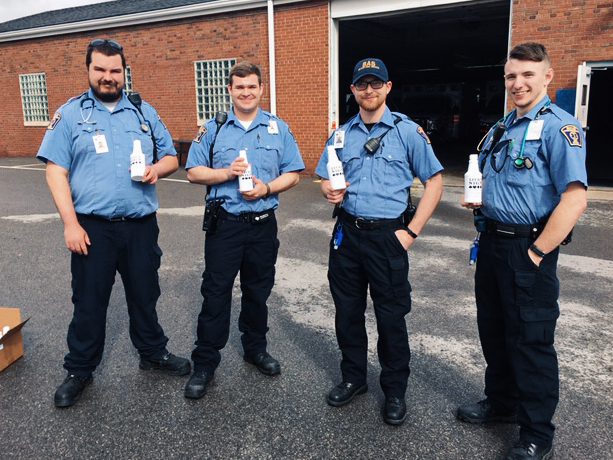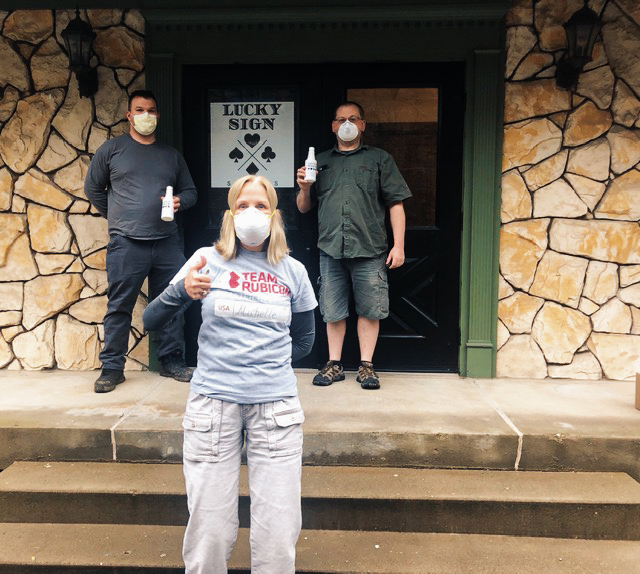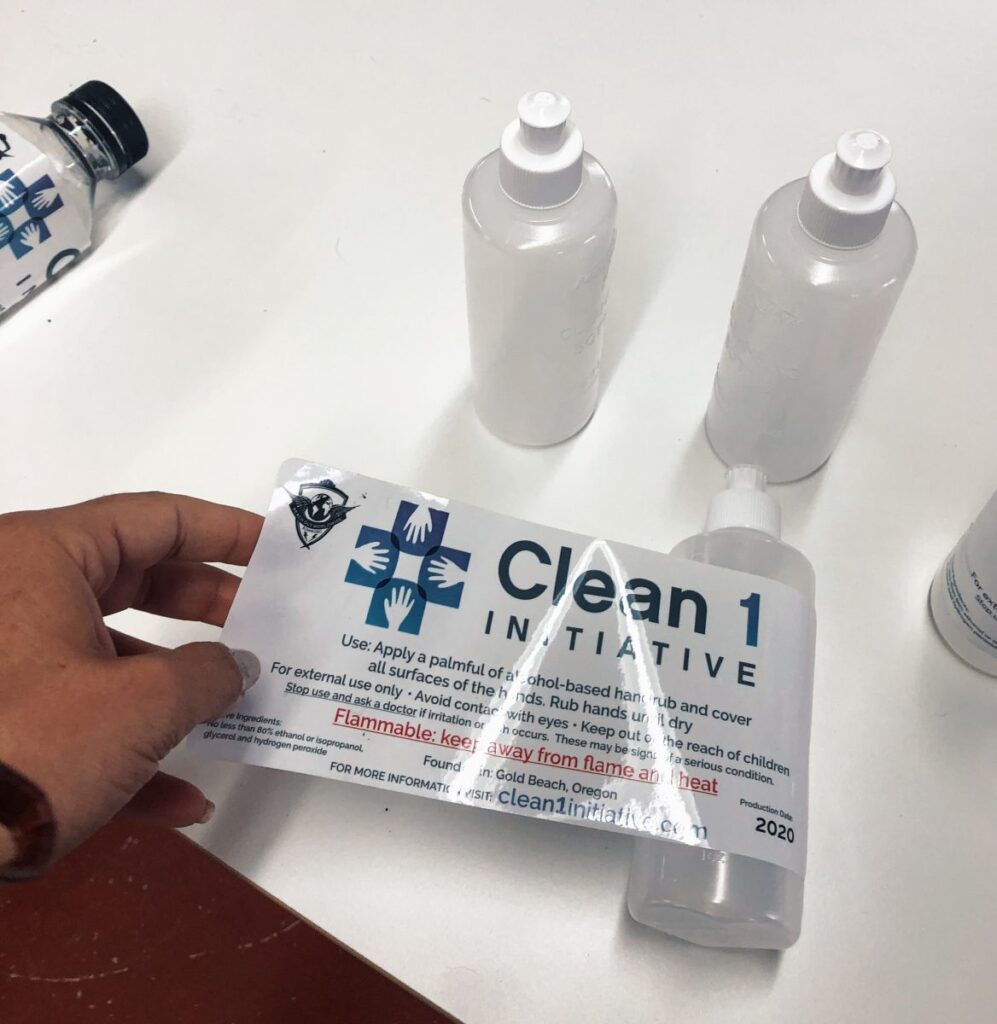When Tucson, AZ, pharmacist Don Featherstone realized he had ingredients at home to make basic hand sanitizer for those going without, he didn’t think twice. “I had a lot of isopropyl alcohol in my workroom that I use to clean my guns,” says Featherstone, who served as an Army combat medic specialist from 1973 to 1977 and on the Arizona 1 Disaster Medical Response Team. “I figured, well, heck, I’m a pharmacist. I can get some aloe vera gel and make a bunch of it.”
 So, he went to the dollar store and bought 50 2-ounce plastic containers. Back home, he did a little math and developed a simple recipe: he mixed 3 parts 99% isopropyl alcohol with 1 part aloe vera in a cleaning bucket, then used a turkey baster to fill the bottles. Featherstone decided to distribute the hand sanitizer among Tucson’s homeless population to help mitigate the spread of COVID-19 for those with little to no access to hygiene products, and who often have more challenges with social distancing measures.
So, he went to the dollar store and bought 50 2-ounce plastic containers. Back home, he did a little math and developed a simple recipe: he mixed 3 parts 99% isopropyl alcohol with 1 part aloe vera in a cleaning bucket, then used a turkey baster to fill the bottles. Featherstone decided to distribute the hand sanitizer among Tucson’s homeless population to help mitigate the spread of COVID-19 for those with little to no access to hygiene products, and who often have more challenges with social distancing measures.
The next day, carrying a cardboard sign that read “Free Hand Sanitizer,” he took what he’d made to locations where the city’s most vulnerable often spend time. He started on Miracle Mile, where he gave away half of his supply, and then went downtown. Featherstone emphasized the sanitizer’s use as a hygiene product only, and tried to distribute it as evenly as possible. Word traveled quickly and before long he was out.
Featherstone, who has been a Greyshirt for about a year, plans to make more as soon as he can get additional isopropyl alcohol (also known as rubbing alcohol); while it’s usually available at local drugstores for a few dollars, ingredients are in short supply right now. He emphasizes that basic hand sanitizer is easy to make for anyone who has the supplies. “It was the least I could do. I had the means to do it—why not?”
Getting Creative Getting Hand Sanitizer Supplies
Don Featherstone isn’t the only Greyshirt whipping up homemade hand sanitizer to help his neighbors. In the Denver area, Air Force veteran Lisa Smith and her fiancé Eli Feret have used a 600-square-foot workshop in their backyard as a hand sanitizer–making space. With funding assistance from the Clean 1 Initiative, a program under nonprofit Reach Out Worldwide that aims to manufacture and distribute sanitation sprays and gels, they got to work. Smith scoured the Denver area for ingredients, stopping at lab equipment supplier The Science Company in Lakewood, CO to find peroxide.

Feret at work
“Procurement was easier said than done,” admits Smith, who was in charge of rounding up supplies. Not only were online retail options limited, but local stores didn’t carry many traditional items, so she found herself at curbside pickups for liquor vendors clearing out their supply of Everclear.” A rectified spirit made of grain alcohol and a neutral spirit, Everclear has high enough alcohol content by volume (ABV) to replace ethanol in certain sanitizer mixtures.
“One day I was on a conference call with local county commissioners in Colorado and I pulled up to Total Wine, rolled down the window and yelled, ‘Hey, I’m here for the case of Everclear!’ I guess I wasn’t muted,” exclaimed Smith. “The meeting stopped and the elected officials were like, ‘Who’s buying Everclear at this time of day?’”
With ingredients finally in hand, Smith and Feret followed a WHO-approved formulation to make their first 60-gallon batch of hand sanitizer, which they have been distributing to assisted care facilities, the local fire department, city and county offices, the Buckley Air Force Base, USPS, UPS, medical professionals at the UC Health Hospital in Aurora, CO as well as to several local businesses that are still open. If funding continues, they’ll be able to produce more.
Heads, hearts, and Hand Sanitizer for First Responders
And a few weeks ago, in Western Pennsylvania, longtime Greyshirt Matthew Brudnok and his business partner Christian Kahle put their Pittsburgh distillery, Lucky Sign Spirits, to work; instead of opening as planned last month to serve alcohol (to drink!), they used the WHO formula to make hand sanitizer for first responders in the area. According to Brudnok, Lucky Sign Spirits has made nearly 3,000 16-ounce bottles and distributed them to fire departments, EMS responders, and other critical care teams in Allegheny County and other, more rural areas that are often overlooked for supplies.

Rufner and Lucky Sign’s Matt Brudnok (L) and Christian Kahle
Michelle Ufner, another Greyshirt who helped coordinate some of Lucky Sign Spirits’s distribution, dropped sanitizers off in neighboring Butler County, too. These drop-offs can make a huge difference for remote communities in the state. In Portersville, there are so few emergency calls a year that their teams are partly a volunteer service. “They said they didn’t have any hand sanitizer at all,” Ufner says. But thanks to the efforts of people like Ufner and Brudnok, the supplies came to them this time. “People on the outskirts seem to get less,” Ufner notes. “So they were glad to see those things were being distributed.”
How to Make Your Own Hand Sanitizer
Hand washing effectively with soap and water for at least 20 seconds is always the best option to eradicate germs and prevent the spread of COVID-19. But if soap and water aren’t available and you can’t get your hands on commercially produced products like Purell, homemade hand sanitizer with an alcohol concentration of more than 60% may work as an alternative. Remember that this basic recipe isn’t going to replicate the major brands.
- Be sure to sanitize your workspace and tools as best you can. Be very careful—any spark or open flame near ingredients with that level of alcohol can cause a fire.
- Mix 3 parts 99% isopropyl alcohol with 1 part aloe vera gel (e.g. Featherstone used 2250ml of the alcohol with 750ml of gel).
- If you can’t find isopropyl alcohol, Featherstone says Everclear (190 proof) can replace isopropyl alcohol in the above recipe.
- If you can’t find aloe vera gel at your local pharmacy, stop by the pharmacist’s counter and ask if they can place an order. Featherstone, who’s in Arizona, said so far they’ve been able to get the product in, but supplies may be dwindling depending on where you are in the country.




